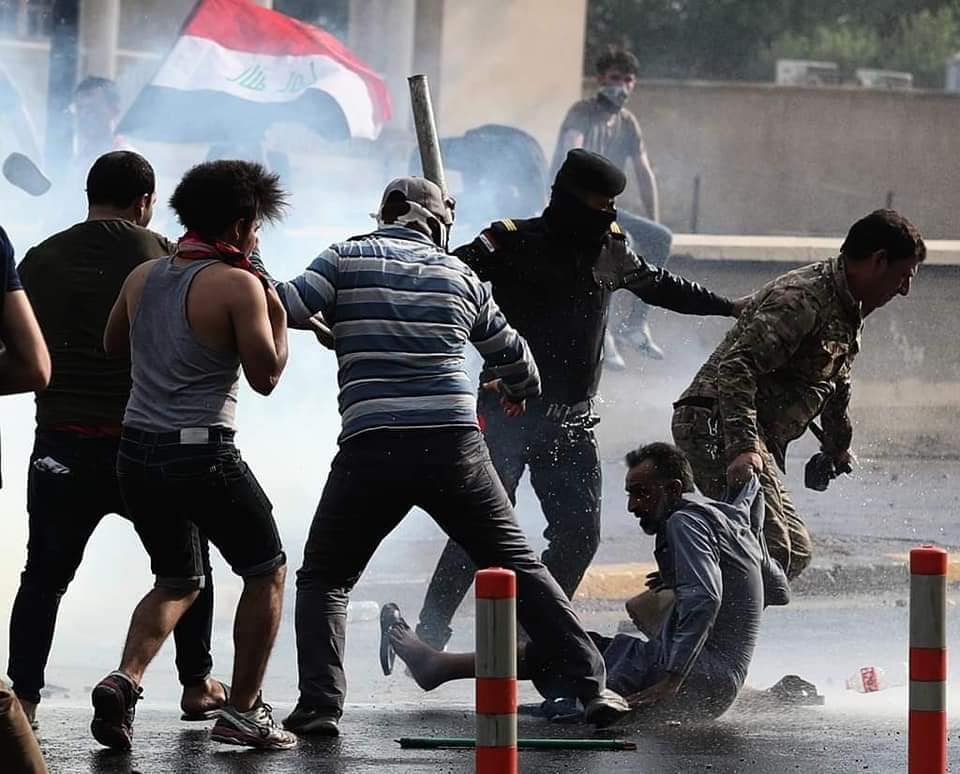The Iraqi government, in its Khamenei version and under the Iranian cloak, has enabled militias to kill, beat, abduct, and torture peaceful protesters in Baghdad and some southern Iraqi provinces. These actions were carried out by the Iranian killing machine, acting on orders from the Quds Force and its sprawling influence in Iraq. The purpose behind these criminal acts was to send a message from Iran, asserting that it would not tolerate any threat to its Safavid empire in the Middle East, and that Iraq would remain firmly under its control.
Following the numerous massacres in Baghdad and other southern provinces of Iraq, human rights organizations, including Amnesty International, urged the Iraqi government to restrain the armed militias responsible for killing, beating, and abducting unarmed protesters. The Iran-backed militias, following directives from Qasem Soleimani, used all kinds of weapons such as rifles, knives, batons, and screwdrivers to crush the peaceful revolution. Protesters were shot, stabbed, and killed as militias attacked them, resembling ferocious, bloodthirsty wolves. Unsurprisingly, the armed men carried banners from Shiite jihadist organizations supported by Iran.
Witness testimonies and videos show that the armed men arrived in small trucks and buses, opening fire on unarmed protesters and directly targeting people instead of shooting in the air. They were unmasked, showing no concern about being recognized, further proving that these militias were given permission by the Iraqi government to carry out these terrorist acts, acting under Soleimani’s interpretation of Khamenei’s agenda while ignoring the constitutional rights of the oppressed Iraqi people. The Popular Mobilization Forces (PMF), in its Soleimani version, and its toxic militia arms, carried out these actions under the watchful eyes and ears of the international community, human rights organizations, and a parliament heavily influenced by Iran and its sectarian death squads.
The Iraqi state supports the presence of various militias, including the Badr Organization, Asa’ib Ahl al-Haq, Saraya al-Salam, Liwa Abu al-Fadl al-Abbas, al-Nujaba, and Jaysh al-Muhammal, to name a few. These militias are now integrated under the umbrella of the Popular Mobilization Forces, which has committed numerous war crimes in central and northern Iraq under the pretext of fighting terrorism.
The black Safavid turban has granted complete immunity to Iranian hands, enabling them to freely interfere in the lives and capabilities of the Iraqi people, under the oppression of the late Soleimani’s stick, the party’s thugs, and the executioners of the Safavid militia. This has provided legitimacy for their terrorist acts without fear of consequences. How could they fear when the guard is the thief, the executioner is the judge, and the justification has been issued in a sacred religious decree by Ruhollah Khomeini through the doctrine of Velayat-e Faqih, which has been in effect for decades and embraced by those who accept its poison, drawn from the Twelver Shiite Imami teachings? The Ministry of Interior has been allocated to the Badr Corps, which exerts control over every level of the ministry. The army is like a birthday cake shared by the militias, with the largest portion going to the Badr Corps and the Mahdi Army. Intelligence agencies belong to the Supreme Islamic Council, factions that split from the Dawa Party, and the Badr Corps, revealing the corruption plaguing state institutions. As a result, the security agencies and army are filled with elements whose loyalty lies first and foremost with Iran and its fundamentalist religious agenda, which has distorted Iraq’s state system.
This explains the security breakdown and the deterioration at all levels, from militias and PMF gangs entering central Baghdad, bypassing (or possibly coordinating with) the numerous checkpoints in the capital and other provinces to implement the Safavid terrorist agenda. They aim to destroy the people under the guise of the “war on terror.”
The Iraqi authorities have tried to defend themselves by claiming they are not involved in the ongoing attacks in Baghdad and southern provinces. However, in reality, the government has covertly been issuing permits and orders to fanatical and bloodthirsty groups, mercenaries whose fangs have savaged defenseless civilians, all under the watch of a puppet government that is supposed to ensure security in Iraq. But the facts are clear: these attacks were not mere coincidences but part of a systematic extermination plan, masked under the democratic claims of the current regime in Baghdad.
If we assume that the Iraqi government had no role in supporting these militias, could it prosecute them? The answer is no. The Iraqi government is simply a servant to Velayat-e Faqih, taking orders from the Imam’s deputy, and from those appointed by the “sacred” authority, whether it be institutions like the Revolutionary Guard with its two wings—the Ramazan Corps led by Ahmad Foruzandeh and the Quds Force led by Soleimani and his successor Qani—falling under Khamenei’s control. One of the key pillars of this control has been placing the Iraqi army under the PMF umbrella, indicating that Iran’s open declaration of its intentions regarding Iraq’s military may signal a shift in regional dynamics. Iran would not oppose the continuation of the Iraqi military, represented by the army, as long as it remains subordinate to the PMF, closely mirroring the Iranian Revolutionary Guard model.
The undeniable truth is that Iran cannot afford to lose Iraq, as it would severely affect its imperialistic ambitions to export its revolution to Syria, Lebanon, Yemen, and even pose a threat to regional powers like the Gulf states. Through the brutal actions of Iran-backed doctrinal militias, Iran sends a clear message: it will not tolerate any threat to its Safavid empire, and Iraq will remain under its control. Iran will show no mercy to Iraqis who dare to think otherwise. However, instead of silencing the Iraqi people, these horrifying acts of violence may push protesters to abandon peaceful demonstrations and take up arms to defend themselves against the Iranian-backed militias.
